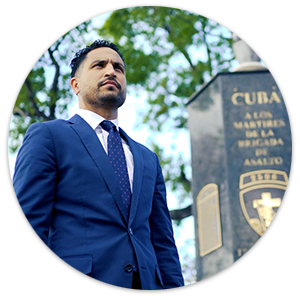In recent years, body cameras have become an important tool for law enforcement agencies across the United States. These devices are used to record interactions between police officers and the public, providing a clear and unbiased record of what happens during these encounters. One of the most significant roles body cameras play is in documenting incidents of excessive force. Excessive force refers to situations where police officers use more physical power than is necessary to control a situation. Having a visual and audio record from body cameras can help ensure that these events are accurately captured, which is crucial for both protecting the public and holding law enforcement accountable. At, The Guzman Firm, PLLC , we are here to guide you through the legal process and help you navigate the complexities of your case.
Richard Guzman’s expertise focuses on one primary objective: to offer tactical legal analysis, guidance, and result-driven solutions. The Guzman Firm is dedicated to providing you with the knowledgeable and competent counsel you deserve.
Attorney Richard Guzman
How Body Cameras Work
Body cameras are typically worn on the chest or shoulder of a police officer. The cameras are small but powerful, capable of recording video and audio continuously. The footage is saved on a secure device, and in most cases, it cannot be tampered with or altered after it is recorded. This ensures that the video remains a true and accurate record of what happened during an incident. In many departments, officers are required to activate their cameras whenever they interact with members of the public. This might include traffic stops, arrests, or responding to emergencies.
When a body camera is recording, it captures the officer’s perspective of the event. The video shows what the officer sees, and the audio captures what they hear and say. This can be extremely valuable when incidents are later reviewed by supervisors, investigators, or courts. Body camera footage often becomes a key piece of evidence in cases involving claims of excessive force.
Documenting Excessive Force Incidents
One of the main reasons that body cameras are so important in documenting excessive force incidents is that they provide an unbiased record of what happened. In the past, excessive force claims often relied on witness statements or the officer’s own report of the event. These sources of information can sometimes be incomplete or influenced by personal opinions. Body cameras, on the other hand, provide a direct account of the incident, showing exactly what took place without any personal interpretation.
When there is a claim of excessive force, the footage from the body camera can be reviewed to see whether the officer’s actions were appropriate. For example, if a police officer is accused of using too much force when making an arrest, the video from their body camera can show whether they used reasonable measures to control the situation or if they went too far. This footage can help determine if the officer followed proper procedures or violated the rights of the individual involved.
In some cases, the video may show that the officer acted appropriately and used only the necessary amount of force to handle the situation. In other cases, it may reveal that the officer did, in fact, use excessive force. Either way, having this video evidence helps ensure that the truth comes out, which is vital for both the public and law enforcement.
“Richard is deeply invested in his community and is a professional of purpose and integrity. As our legal counsel, his strategic approach, proactive communication, and commitment to our organization’s needs and goals have helped us navigate challenges as well as build important partnerships.” “I go to Richard Guzman because of trust. He was recommended by my dear sister that had the pleasure of working with Mr. Guzman. By having a direct recommendation, I did not doubt that he could ease my worries and that I would be backed by a knowledgeable, trustworthy professional.”![]()
Dejha C.
![]()
Piero S.
Improving Accountability and Transparency
Another important role of body cameras is improving accountability and transparency in law enforcement. When officers know that their actions are being recorded, they may be more likely to follow the rules and act in a professional manner. This can help prevent incidents of excessive force before they even occur. The presence of a body camera can also give the public more confidence in the actions of the police. People are more likely to trust the police when they know that there is a record of what happens during interactions with officers.
For law enforcement agencies, body cameras can also be a valuable tool in training and improving officer behavior. When body camera footage is reviewed, it can be used to identify areas where officers may need additional training. Supervisors can use the videos to show officers how they could have handled certain situations differently, helping them learn from their mistakes and avoid excessive force in the future.
In addition to holding officers accountable, body cameras can also protect them from false accusations. In some cases, people may accuse police officers of using excessive force when, in reality, the officers acted appropriately. Body camera footage can provide evidence to clear the officer’s name and show that they followed the proper procedures. This can help build trust between the police and the community, as people will know that officers are being held accountable for their actions.
Challenges with Body Camera Footage
While body cameras have many benefits in documenting excessive force incidents, there are also some challenges that come with their use. One of the main challenges is that the footage may not always capture the full story. Since body cameras are worn on the chest or shoulder, they only show what is directly in front of the officer. If something happens out of the camera’s view, it may not be recorded. Additionally, the camera may not capture everything that is happening in the officer’s environment. For example, it may not show what is going on behind the officer or what another person involved in the incident is doing.
There can also be technical issues with body cameras. In some cases, the camera may malfunction or fail to record properly. This can result in missing footage, which can make it harder to understand exactly what happened during an incident. Additionally, officers are typically responsible for turning their cameras on when they interact with the public. If an officer forgets to activate their camera or turns it off at the wrong time, important parts of the incident may not be recorded.
Despite these challenges, body cameras remain an important tool for documenting excessive force incidents. Even if the footage does not capture every detail of an incident, it still provides valuable evidence that can help piece together what happened.
The Future of Body Cameras in Law Enforcement
As technology continues to improve, it is likely that body cameras will become an even more powerful tool for documenting excessive force incidents. Some police departments are already exploring the use of more advanced cameras that have better video and audio quality. These cameras may also come with features like live streaming, which would allow supervisors to watch incidents in real-time as they happen. This could help police departments respond more quickly to situations where excessive force is being used.
There are also discussions about how to better integrate body cameras with other technologies, like facial recognition or artificial intelligence. These tools could help identify patterns in officer behavior or provide additional context to body camera footage. However, it is important to balance these advancements with concerns about privacy and civil liberties.
As more law enforcement agencies adopt body cameras, it is also important to establish clear policies for their use. These policies should address when officers are required to activate their cameras, how the footage is stored, and who has access to it. By establishing clear guidelines, police departments can ensure that body cameras are used effectively and responsibly to document excessive force incidents.
The role of body cameras in documenting excessive force incidents is crucial for promoting accountability, transparency, and fairness in law enforcement. These devices provide a clear and unbiased record of interactions between police officers and the public, helping to ensure that the truth comes out in cases where excessive force is alleged. While there are challenges associated with the use of body cameras, their benefits far outweigh the drawbacks. By continuing to improve this technology and establish clear policies for its use, body cameras can play an even more important role in preventing and addressing excessive force in the future.
If you or a loved one has experienced excessive force during an encounter with law enforcement, it is important to seek legal assistance. The Guzman Firm, PLLC is here to help you understand your rights and guide you through the process of holding law enforcement accountable for their actions. Contact The Guzman Firm, PLLC today for dedicated and experienced legal representation.
